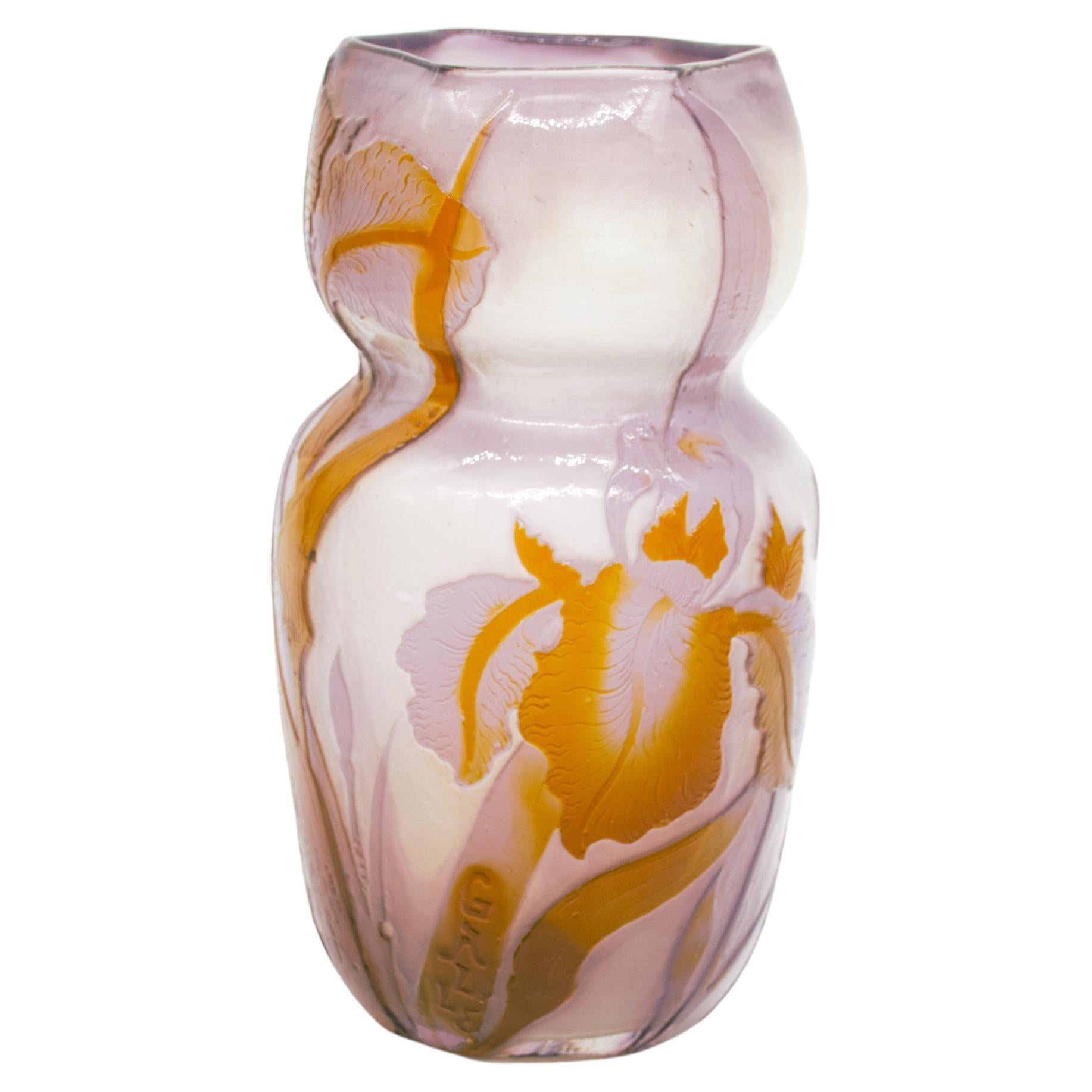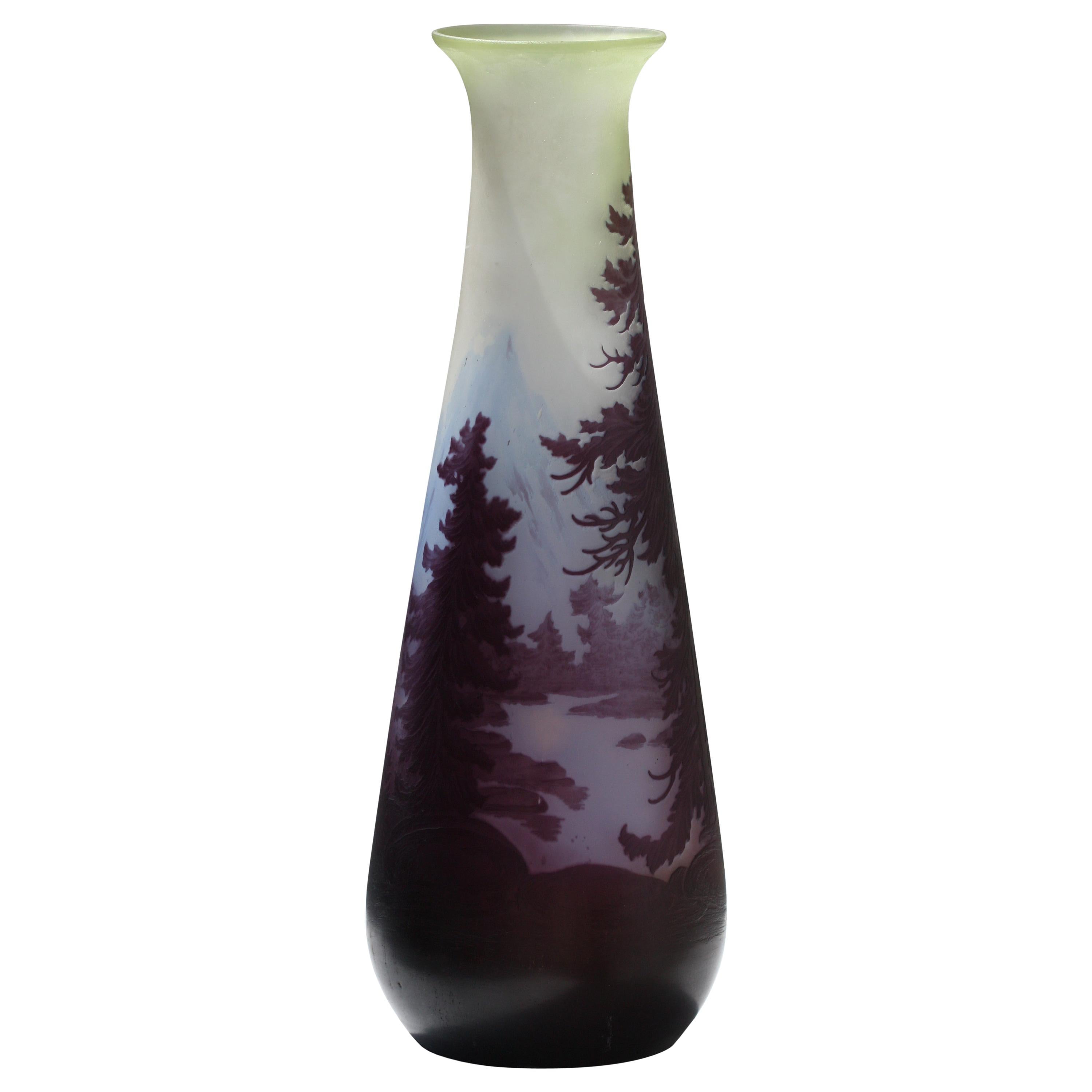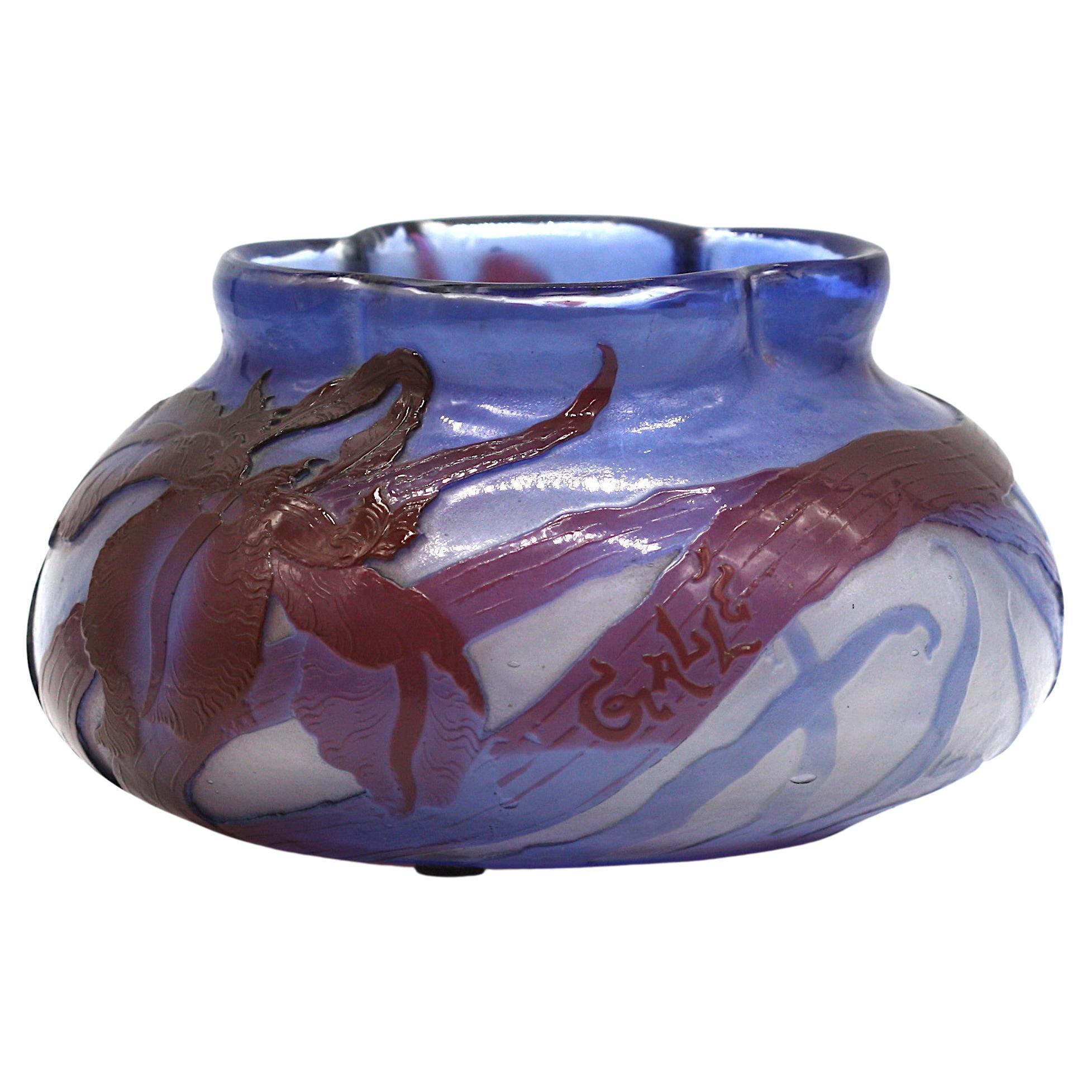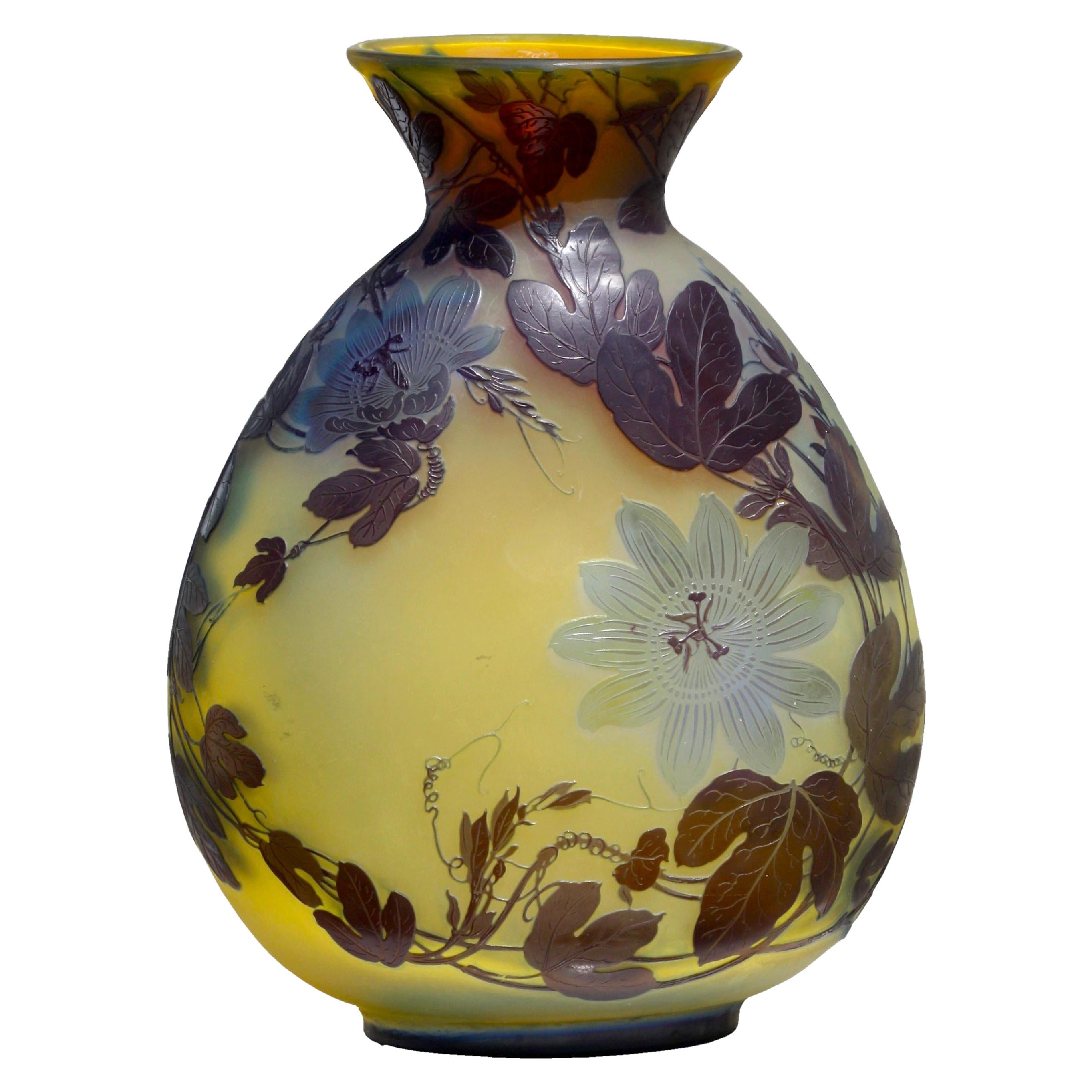Items Similar to ÉMILE GALLÉ Vase, circa 1900 overlaid cameo glass red flowers, square shape
Want more images or videos?
Request additional images or videos from the seller
1 of 6
ÉMILE GALLÉ Vase, circa 1900 overlaid cameo glass red flowers, square shape
About the Item
An attractive late 19th Century cameo glass vase of elongated square form cut with decorative burgundy and red flowers against a warm yellow background with excellent hand finished detail and colour, signed Galle in cameo, this vase is rare because of the square shape it has in the middle part which becomes round on top and bottom, amazing design piece.
Measurements :
Height : 11.8 in. (30 cm)
Diameter : 4.7 in. (12 cm)
Condition
Perfect condition for its age, no brakes, no restorations.
Emile Gallé, 1846 – 1904 is considered a driving force behind the Art Nouveau movement and one of the most outstanding glass artists of his time. His naturalistic designs and innovative techniques greatly contributed to the development of the art of glass-making and to the Art Nouveau Style.
Emile lived during an age of technological, scientific, and political explosion. He travelled extensively in Europe and witnessed techniques that would greatly influence his work such as cameo and enamelling. He began producing fine pottery, furniture and jewellery before setting up his own glass studio in 1873 and taking over his father’s factory 4 years later.
After being inspired by the glass works at the 1878 International Exhibition in Paris, particularly cameo works, Gallé made his mark as a true artist in glass at the 1884 Union Centrale des Arts Décoratifs in Paris where he showed 300 pieces of great artistic variety as well as technical expertise. He returned to the International Exhibition in Paris in 1889 to present his own new types of glass. The pieces featured new vase shapes, extraordinary new colours, carved cameo and pate de verre work. The event was a breakthrough for him and the Art Nouveau style in general, with his pieces beginning to be widely imitated (notably by the likes of the Daum brothers.)
In 1894 Gallé built his own manufacturing plant in Nancy which throughout the 1890’s employed a team of craftsmen-designers who worked on his designs, only ever applying his signature after his approval. Demand for Gallé’s work was high so there were 300 employees working at the factory and Gallé revolutionised the Art Glass industry by mass-producing pieces using industrial techniques for the first time.
He enjoyed great success exhibiting his Art Nouveau works winning international awards and recognition through commissions and increased popular demand, and in 1901 he founded and was first president of ‘L’Ecole de Nancy’.
Gallé died in 1904 and his widow continued to run the glassworks until the war broke out in 1914. Glass sold since Gallé’s death was marked with a star after his signature and continued to be made until 1935 when the firm closed down.
Influences, Style and Technique
Emile Gallé was greatly influenced by the techniques he learnt while travelling around Europe, such as the cameo glass of great designers like Eugene Rousseau, and the enamelling used on Oriental pieces. Every piece created by his factory was heavily influenced by his passion of naturalistic designs. His pieces feature every sort of plant life, from thistles to fuchsias, clematis to chrysanthemums. Insects were also a frequent theme, with many of his pieces including butterflies, dragonflies and insects. Gallé also often decorated his pieces with landscape scenes, and was also influenced by Japanese design.
Gallé’s Cameo Glass was made with layering coloured glass, using acid to remove part of the layers and adding wheel carved detail on the better pieces. He discovered applying metallic foils between the coloured glass sheets created a stunning effect, especially when applied in the cameo work. His enamel work was just as revolutionary as he mixed metallic oxides with glass and suspended them in oil, giving the pieces a completely different finish after firing.
Gallé’s glass vessels are each unique in their own way, often containing blazes of colour, constellations of air bubbles, shimmering flecks of imbedded metal foils, and often, entrapped figures of insects that seem to float in a haze. The effects used brought his subject matter to life, and his constant adoption of new techniques and imaginative use of them in combination with his own influences and industrial innovations revolutionised the art of glass making.
His work normally signed Gallé in relief. Works made by his factory after his death.
- Dimensions:Height: 11.8 in (29.98 cm)Diameter: 4.7 in (11.94 cm)
- Materials and Techniques:
- Period:
- Date of Manufacture:1900
- Condition:
- Seller Location:Tel Aviv - Jaffa, IL
- Reference Number:1stDibs: LU8130237681152
About the Seller
No Reviews Yet
Vetted Seller
These experienced sellers undergo a comprehensive evaluation by our team of in-house experts.
1stDibs seller since 2023
- ShippingRetrieving quote...Ships From: Tel Aviv - Jaffa, Israel
- Return PolicyThis item cannot be returned.
More From This SellerView All
- ÉMILE GALLÉ 'Iris' Vase, circa 1900 overlaid cameo and fire polished glassBy Emile GalléLocated in Tel Aviv - Jaffa, ILÉMILE GALLÉ (1846-1904) Rare and important 'Iris' Vase, circa 1900 Overlaid cameo and fire polished glass, well documented in books and exhibitions Signed in cameo Gallé. Measuremen...Category
Early 20th Century French Art Nouveau Vases
MaterialsArt Glass, Blown Glass, Cut Glass
- Rare Daum Nancy Wheel-Carved Rose 'La France' double overlay Cameo Glass VaseBy DaumLocated in Tel Aviv - Jaffa, ILThis wonderful, elegantly shaped with a flared rim vase , by Daum Nancy, features wheel-carved cameo glass of the highest quality detailing an amazing pink roses, or rose of France ...Category
Vintage 1910s French Art Nouveau Vases
MaterialsArt Glass, Blown Glass, Cut Glass, Opaline Glass
- Large Austrian Silver “Peacock” Hanukkah Lamp, Josef Kohn, Vienna, 1872-1900s'Located in Tel Aviv - Jaffa, ILVery rare and important Austrian silver, from its golden age of the late 19th century to the early 20th century, this Hanukah lamp is hand with chased dra...Category
Antique 1890s Art Nouveau Sterling Silver
MaterialsSilver
- Rare Antique Novelty German silver antler and silver cigar cutter, 1890-1900Located in Tel Aviv - Jaffa, ILVery attractive German silver mounted on an antler, cigar cutter This cigar cutter is designed as oak leaves falling on the antler and in the middle There is a game bird of some kind hung from it, very realistic and well made. This kind of objects were made in Germany and Austria so they can be given as High end gifts, used as a display piece with function in men clubs...Category
Antique 1890s Sterling Silver
MaterialsSilver, Steel
- Satsuma earthenware vase by kinkozan, Meiji periodBy KinkozanLocated in Tel Aviv - Jaffa, ILthe body of this small marvelous vase is painted with a scene of a puppet show vendor with his wood backpack, on top of the backpack there are toys and dolls, he is surrounded with a group of 6 children, and on the background you can see a village. on the other side of the vase there is an amazing painting of flowers and on the sides there are two amazing strong pine trees, the amorphous background is decorated in a "Tortoiseshell" color and design that gives it a real character and which is quite rare to see on satsuma pottery. all the vase is over richly overpainted over the glaze with gold, which gives it its depth and realism. signed Kyoto Kinkozan zo, and sealed Kinkozan zo Kyoto’s Satsuma: The painting technique used in Kyoto’s Satsuma-style ware is said to be the invention of the sixth generation Kinkōzan Sōbei (1824–1884). The Kinkōzan were a famous family of Kyoto Awataguchi potters who made ceramics that were used at Shōren'in, a temple closely tied to the imperial family, and by the shoguns of the Edo government. In fact the shogun is said to have granted them the name Kinkōzan. With the upheavals at the end of the Edo period, however, and the reforms of the subsequent Meiji government, the potters lost their traditional patrons and had to develop new markets. Just at that time, the visit of a certain Westerner is said to have decided them to embark on overseas trade. By 1870, they had perfected Kyō Satsuma...Category
Antique 1890s Japanese Meiji Ceramics
MaterialsGold
- Antique Russian Silver Enamel chest shaped box, by Maria Semenova, Moscow ca1900By Maria SemenovaLocated in Tel Aviv - Jaffa, ILThis treasure chest shaped box is luxuriously decorated and dates from the final decades Of the Imperial period. The box was produced by the workshop of Maria Semonova and Is formed of 875 grade silver with silver-gilt utilised throughout. the box is of traditional Shape, having two hinged handles and a clasp, boxes like this were used in treasurys Around the globe in the early days to keep valuables inside, this small box can be used To hold tobacco or just sit on your table as a statement piece, a great addition to any Silver and especially Russian silver collection. The exterior surface of the box is profusely decorated with polychrome cloisonné Enamel, the cloisons set into a variety of shapes, such as scrolling arabesques, and Infilled with shaded enamel in tones of red, blue, and Semenova’s idiosyncratic violet. The cloisons are bounded by silver-gilt rope twist cloison wire. The underside of the box Is marked with ‘MC’ for Semonova’s workshop, ‘84’ for 87.5% silver with a Kokoshnik mark (Kokoshnik is a traditional Russian head...Category
Early 20th Century Russian Neoclassical Decorative Boxes
MaterialsSilver, Enamel
You May Also Like
- Emile Galle Overlaid and Etched Glass Vase, circa 1900By Emile GalléLocated in West Palm Beach, FLAn Emile Galle overlaid and etched glass vase, circa 1900. The frosted white, yellow and blue ground overlaid and etched to depict a tree lined mountainous lake scene. Measures: 11 ...Category
Antique Early 1900s Vases
MaterialsArt Glass
- Emile Galle Cameo Glass Vase 1900By Emile GalléLocated in Autonomous City Buenos Aires, CABAoverlaid and acid-etched with pendant flowers and leaves signed in cameo Gallé This beautiful glass vase is an authentic vase due to the petal-shaped mouth opening. very attractive...Category
Antique Early 1900s French Art Deco Vases
MaterialsGlass, Blown Glass, Art Glass
- Emile Galle Cameo Glass Vase, 'Flowers'By GalléLocated in West Palm Beach, FLEmile Galle, French(1846-1904) A Fine wheel-cut and fire-polished Cameo Glass Vase, 'Flowers', circa 1900 Measure: 6.5 in. (16.5 cm.) diameter signed in cameo Galle.Category
20th Century Vases
MaterialsGlass
- Émile Gallé an Impressive Gallé Cameo Glass Vase, circa 1900By GalléLocated in West Palm Beach, FLÉmile Gallé An impressive Gallé cameo glass vase circa 1900 colourless glass with a degrading amber layer overlaid in brown and pale green, etched and cut with pendant flower blossoms cameo mark 'Gallé' underside stamped Fabrication Francaise...Category
Antique Early 1900s Vases
MaterialsArt Glass
- Cameo Glass Vase Fuchsia Flower by Emile GalleBy Emile GalléLocated in Lisbon, PTImpressive Art Nouveau Emile Galle Cameo landscape vase, in a yellow background and brown inlaid details aquatic vegetation and autumn tonality. Represent a magnificent Fuschia Flow...Category
20th Century French Art Nouveau Vases
MaterialsArt Glass
- Galle Cameo Glass Vase, circa 1900Located in New York, NYGalle Cameo glass vase, circa 1900.Category
Early 20th Century French Vases
MaterialsArt Glass
Recently Viewed
View AllMore Ways To Browse
Daum Dragonfly Vase
Pablo Picasso Ceramic Vase
Sevres Vase Deco
Glass Vase On Auction
The Regent China
Tall American Stoneware
Scheurich 517
Spire Vase
Majolica Rooster Italy
Matt White Pottery Small
Italian Terracotta Jug
Tomas Anagrius Vase
Molded Glass Vase Green And Pink
Murano Seguso Carnevale
Blue Swung Vase
Ethiopian Saddle
Gunther Praschak
Art Deco Furniture Paris





